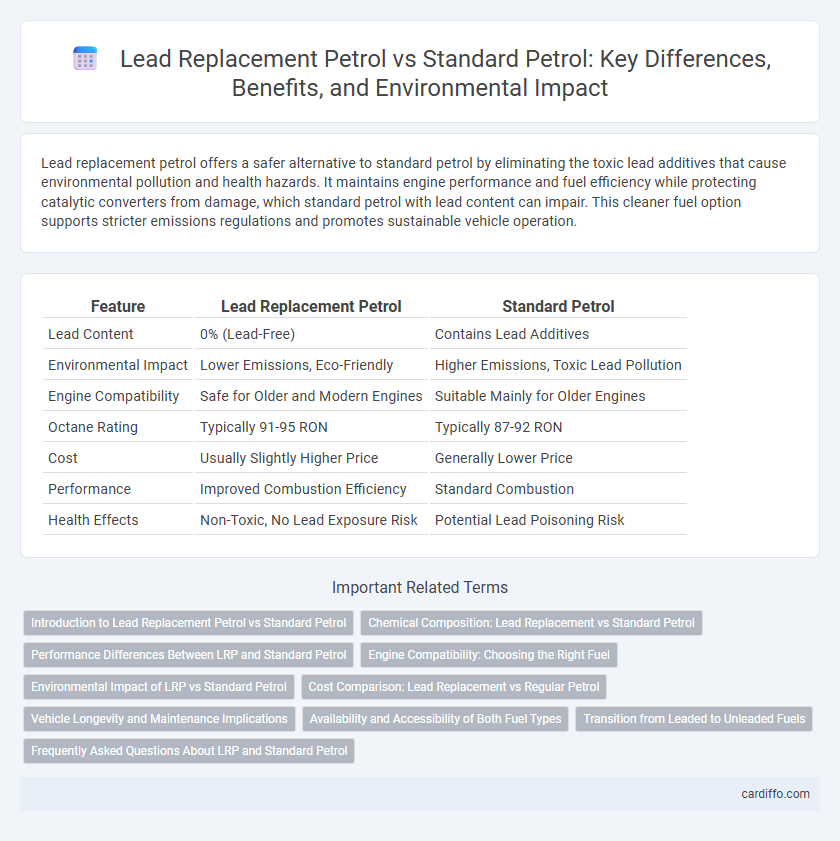Lead replacement petrol offers a safer alternative to standard petrol by eliminating the toxic lead additives that cause environmental pollution and health hazards. It maintains engine performance and fuel efficiency while protecting catalytic converters from damage, which standard petrol with lead content can impair. This cleaner fuel option supports stricter emissions regulations and promotes sustainable vehicle operation.
Table of Comparison
| Feature | Lead Replacement Petrol | Standard Petrol |
|---|---|---|
| Lead Content | 0% (Lead-Free) | Contains Lead Additives |
| Environmental Impact | Lower Emissions, Eco-Friendly | Higher Emissions, Toxic Lead Pollution |
| Engine Compatibility | Safe for Older and Modern Engines | Suitable Mainly for Older Engines |
| Octane Rating | Typically 91-95 RON | Typically 87-92 RON |
| Cost | Usually Slightly Higher Price | Generally Lower Price |
| Performance | Improved Combustion Efficiency | Standard Combustion |
| Health Effects | Non-Toxic, No Lead Exposure Risk | Potential Lead Poisoning Risk |
Introduction to Lead Replacement Petrol vs Standard Petrol
Lead replacement petrol, also known as unleaded petrol with additives, is formulated to provide similar engine protection as traditional leaded petrol without the harmful environmental and health effects of tetraethyl lead. Standard petrol contains lead compounds that improve engine performance and reduce knocking but contribute to toxic emissions and environmental pollution. Transitioning to lead replacement petrol helps comply with stricter emissions regulations while maintaining engine efficiency and longevity.
Chemical Composition: Lead Replacement vs Standard Petrol
Lead replacement petrol contains chemical additives such as organometallic compounds like methylcyclopentadienyl manganese tricarbonyl (MMT) or ferrocene, designed to mimic the anti-knock properties of tetraethyl lead without the associated toxicity. Standard petrol traditionally contained tetraethyl lead as an anti-knock agent, enhancing octane rating and engine performance but posing significant environmental and health risks due to lead emissions. The absence of lead in replacement fuels reduces harmful metal pollutants, while alternative additives maintain combustion efficiency and reduce engine knocking.
Performance Differences Between LRP and Standard Petrol
Lead Replacement Petrol (LRP) typically contains additives that protect older engine components from wear without the harmful effects of lead, resulting in cleaner combustion and lower emissions compared to standard petrol. Performance-wise, LRP may offer slightly reduced engine knocking and smoother acceleration due to its enhanced octane rating, but torque and horsepower generally remain comparable to standard petrol. Most modern engines optimized for unleaded fuel show minimal performance differences between LRP and standard petrol, with LRP primarily serving as a protective alternative for vintage engines.
Engine Compatibility: Choosing the Right Fuel
Lead replacement petrol is formulated to be compatible with older engines designed for leaded fuel, preventing valve seat recession and maintaining engine performance, whereas standard petrol lacks such additives and may cause damage in these engines. Modern engines with hardened valve seats can safely use standard petrol without risking valve wear or damage. Choosing the right fuel ensures optimal engine compatibility, longevity, and adherence to manufacturer specifications.
Environmental Impact of LRP vs Standard Petrol
Lead replacement petrol (LRP) significantly reduces the environmental hazards associated with traditional leaded petrol by eliminating lead emissions that contaminate air, soil, and water, thereby protecting ecosystems and human health. Unlike standard petrol, which contributes to toxic lead buildup and respiratory problems, LRP lowers particulate pollution and heavy metal exposure, promoting cleaner air quality. The shift to LRP supports sustainable fuel practices by minimizing hazardous waste and reducing long-term environmental damage linked to lead pollution.
Cost Comparison: Lead Replacement vs Regular Petrol
Lead Replacement Petrol generally costs more than Standard Petrol due to the additional refining processes required to remove harmful lead compounds and add alternative additives. Despite higher prices, Lead Replacement Petrol offers long-term engine benefits by reducing deposits and emissions, potentially lowering maintenance costs. Consumers should weigh upfront fuel expenses against possible savings in engine durability and environmental impact when choosing between these fuel types.
Vehicle Longevity and Maintenance Implications
Lead replacement petrol offers improved engine protection by reducing valve seat wear in older vehicles originally designed for leaded fuels, enhancing vehicle longevity compared to standard unleaded petrol. Standard petrol lacks the anti-wear properties of lead additives, potentially accelerating valve damage and increasing maintenance frequency for classic cars without hardened valve seats. Choosing lead replacement petrol minimizes costly repairs and supports sustained engine performance, particularly in vintage and classic automobile engines.
Availability and Accessibility of Both Fuel Types
Lead replacement petrol is widely available at most urban and suburban fuel stations, offering a convenient alternative to standard petrol while meeting environmental regulations. Standard petrol remains accessible in both urban and rural areas, benefiting from an established distribution network and consistent supply chains. Consumers can easily find lead replacement petrol in regions prioritizing lower emissions, though standard petrol maintains broader availability overall.
Transition from Leaded to Unleaded Fuels
The transition from leaded to unleaded petrol marked a significant improvement in fuel composition, reducing harmful emissions and protecting catalytic converters in modern engines. Lead replacement petrol contains additives designed to mimic the anti-knock properties of tetraethyl lead, enabling older vehicles to run smoothly without damaging emissions systems. This shift not only enhanced environmental standards but also extended the lifespan of automotive engines and emission control technologies.
Frequently Asked Questions About LRP and Standard Petrol
Lead Replacement Petrol (LRP) and Standard Petrol differ primarily in their octane ratings and additives, with LRP formulated to replace tetraethyl lead for engine protection and improved combustion. Frequently asked questions about LRP often concern its compatibility with older engines designed for leaded petrol, its environmental impact, and the cost differences compared to Standard Petrol. Standard Petrol, typically unleaded, raises concerns about engine performance in vintage vehicles and emission levels, which customers commonly address when selecting fuel types.
Lead Replacement Petrol vs Standard Petrol Infographic

 cardiffo.com
cardiffo.com